warning YAMAHA FJR1300AS 2015 Owner's Guide
[x] Cancel search | Manufacturer: YAMAHA, Model Year: 2015, Model line: FJR1300AS, Model: YAMAHA FJR1300AS 2015Pages: 124, PDF Size: 3.39 MB
Page 72 of 124
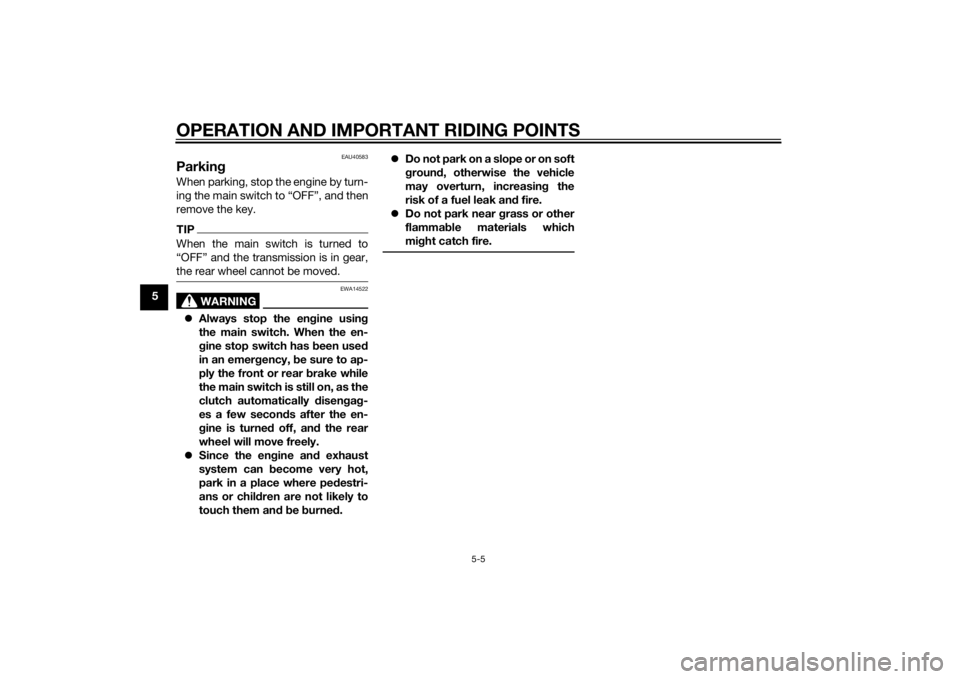
OPERATION AND IMPORTANT RIDING POINTS
5-5
5
EAU40583
ParkingWhen parking, stop the engine by turn-
ing the main switch to “OFF”, and then
remove the key.TIPWhen the main switch is turned to
the rear wheel cannot be moved.
WARNING
EWA14522
Always stop the engine using
the main switch. When the en-
gine stop switch has been used
in an emergency, be sure to ap-
ply the front or rear brake while
the main switch is still on, as the
clutch automatically disengag-
es a few seconds after the en-
gine is turned off, and the rear
wheel will move freely.
Since the engine and exhaust
system can become very hot,
park in a place where pedestri-
ans or children are not likely to
touch them and be burned.Do not park on a slope or on soft
ground, otherwise the vehicle
may overturn, increasing the
risk of a fuel leak and fire.
Do not park near grass or other
flammable materials which
might catch fire.
U1MDE1E0.book Page 5 Monday, July 28, 2014 10:48 AM
Page 73 of 124
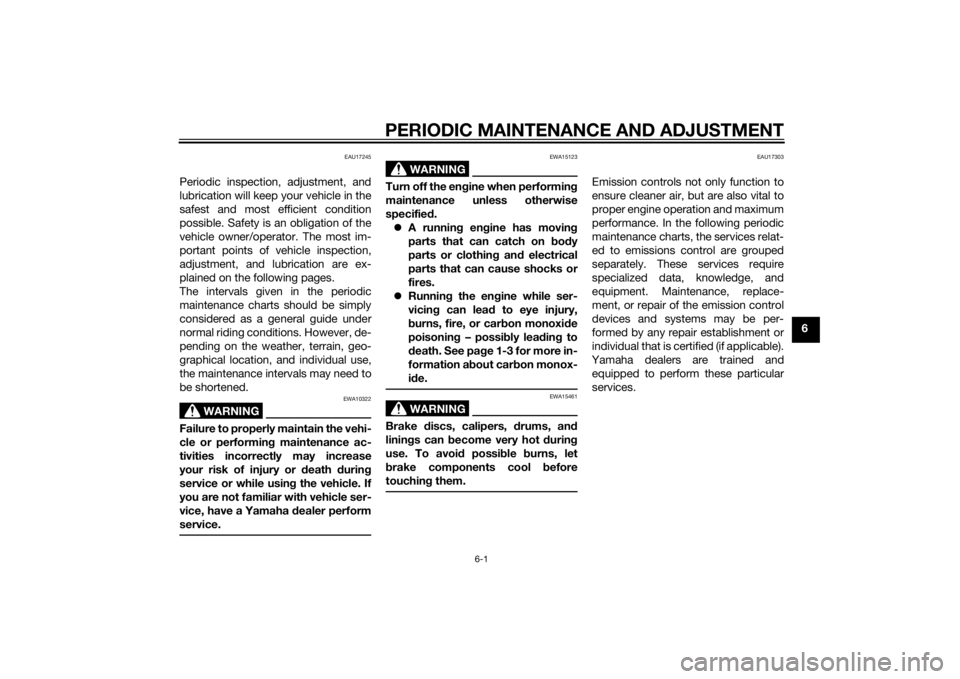
PERIODIC MAINTENANCE AND ADJUSTMENT
6-1
6
EAU17245
Periodic inspection, adjustment, and
lubrication will keep your vehicle in the
safest and most efficient condition
possible. Safety is an obligation of the
vehicle owner/operator. The most im-
portant points of vehicle inspection,
adjustment, and lubrication are ex-
plained on the following pages.
The intervals given in the periodic
maintenance charts should be simply
considered as a general guide under
normal riding conditions. However, de-
pending on the weather, terrain, geo-
graphical location, and individual use,
the maintenance intervals may need to
be shortened.
WARNING
EWA10322
Failure to properly maintain the vehi-
cle or performing maintenance ac-
tivities incorrectly may increase
your risk of injury or death during
service or while using the vehicle. If
you are not familiar with vehicle ser-
vice, have a Yamaha dealer perform
service.
WARNING
EWA15123
Turn off the engine when performing
maintenance unless otherwise
specified.
A running engine has moving
parts that can catch on body
parts or clothing and electrical
parts that can cause shocks or
fires.
Running the engine while ser-
vicing can lead to eye injury,
burns, fire, or carbon monoxide
poisoning – possibly leading to
death. See page 1-3 for more in-
formation about carbon monox-
ide.
WARNING
EWA15461
Brake discs, calipers, drums, and
linings can become very hot during
use. To avoid possible burns, let
brake components cool before
touching them.
EAU17303
Emission controls not only function to
ensure cleaner air, but are also vital to
proper engine operation and maximum
performance. In the following periodic
maintenance charts, the services relat-
ed to emissions control are grouped
separately. These services require
specialized data, knowledge, and
equipment. Maintenance, replace-
ment, or repair of the emission control
devices and systems may be per-
formed by any repair establishment or
individual that is certified (if applicable).
Yamaha dealers are trained and
equipped to perform these particular
services.
U1MDE1E0.book Page 1 Monday, July 28, 2014 10:48 AM
Page 86 of 124
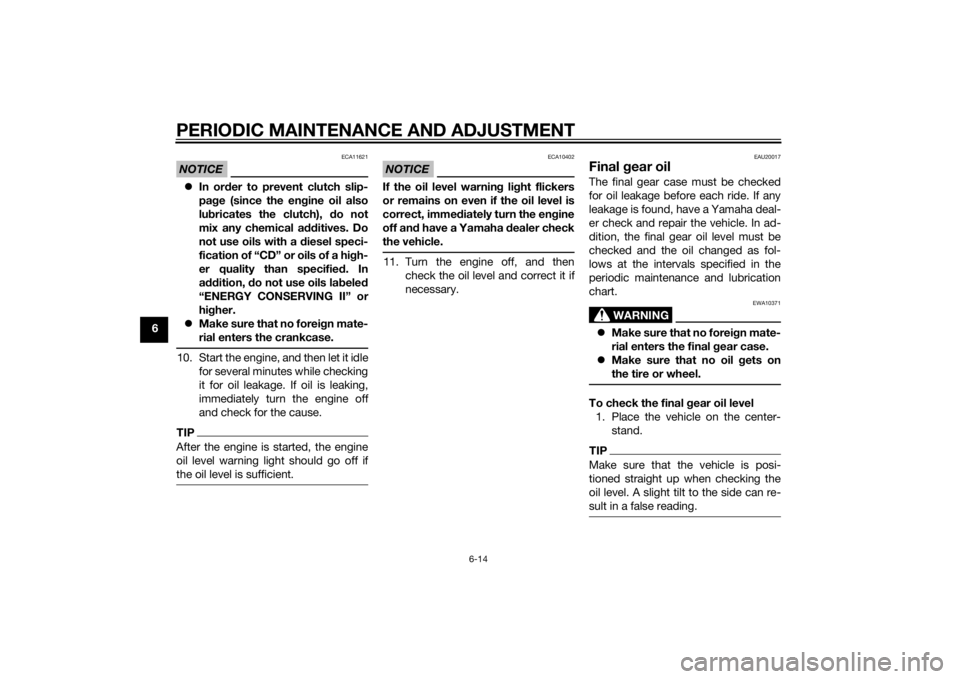
PERIODIC MAINTENANCE AND ADJUSTMENT
6-14
6
NOTICE
ECA11621
In order to prevent clutch slip-
page (since the engine oil also
lubricates the clutch), do not
mix any chemical additives. Do
not use oils with a diesel speci-
fication of “CD” or oils of a high-
er quality than specified. In
addition, do not use oils labeled
“ENERGY CONSERVING II” or
higher.
Make sure that no foreign mate-
rial enters the crankcase.10. Start the engine, and then let it idle
for several minutes while checking
it for oil leakage. If oil is leaking,
immediately turn the engine off
and check for the cause.TIPAfter the engine is started, the engine
oil level warning light should go off if
the oil level is sufficient.
NOTICE
ECA10402
If the oil level warning light flickers
or remains on even if the oil level is
correct, immediately turn the engine
off and have a Yamaha dealer check
the vehicle.11. Turn the engine off, and then
check the oil level and correct it if
necessary.
EAU20017
Final gear oilThe final gear case must be checked
for oil leakage before each ride. If any
leakage is found, have a Yamaha deal-
er check and repair the vehicle. In ad-
dition, the final gear oil level must be
checked and the oil changed as fol-
lows at the intervals specified in the
periodic maintenance and lubrication
chart.
WARNING
EWA10371
Make sure that no foreign mate-
rial enters the final gear case.
Make sure that no oil gets on
the tire or wheel.To check the final gear oil level
1. Place the vehicle on the center-
stand.TIPMake sure that the vehicle is posi-
tioned straight up when checking the
oil level. A slight tilt to the side can re-
sult in a false reading.
U1MDE1E0.book Page 14 Monday, July 28, 2014 10:48 AM
Page 88 of 124
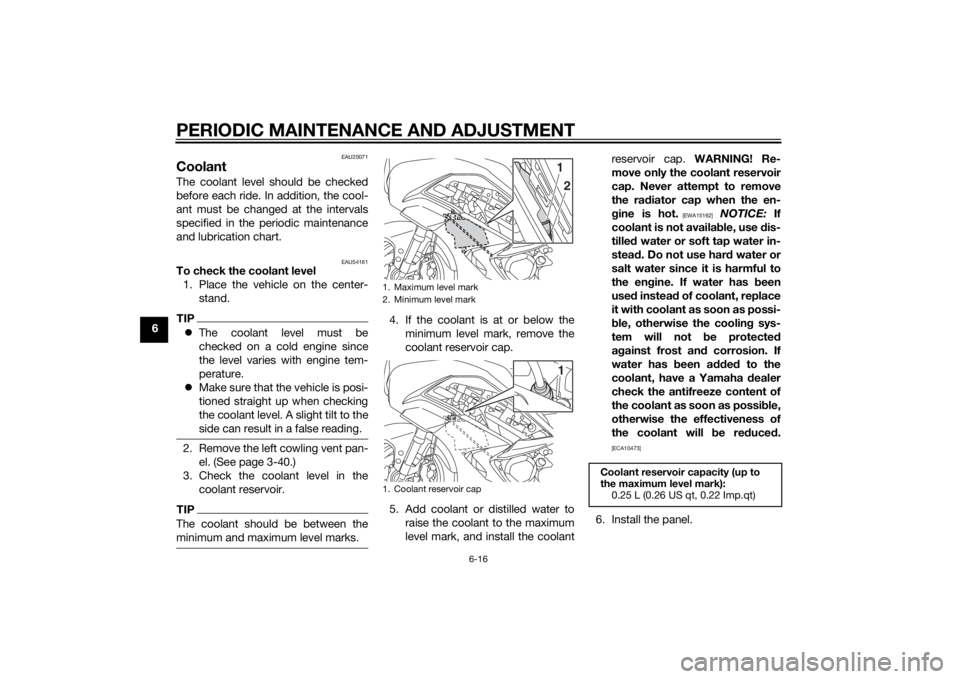
PERIODIC MAINTENANCE AND ADJUSTMENT
6-16
6
EAU20071
CoolantThe coolant level should be checked
before each ride. In addition, the cool-
ant must be changed at the intervals
specified in the periodic maintenance
and lubrication chart.
EAU54161
To check the coolant level
1. Place the vehicle on the center-
stand.TIPThe coolant level must be
checked on a cold engine since
the level varies with engine tem-
perature.
Make sure that the vehicle is posi-
tioned straight up when checking
the coolant level. A slight tilt to the
side can result in a false reading.2. Remove the left cowling vent pan-
el. (See page 3-40.)
3. Check the coolant level in the
coolant reservoir.TIPThe coolant should be between the
minimum and maximum level marks.
4. If the coolant is at or below the
minimum level mark, remove the
coolant reservoir cap.
5. Add coolant or distilled water to
raise the coolant to the maximum
level mark, and install the coolantreservoir cap. WARNING! Re-
move only the coolant reservoir
cap. Never attempt to remove
the radiator cap when the en-
gine is hot.
[EWA15162]
NOTICE: If
coolant is not available, use dis-
tilled water or soft tap water in-
stead. Do not use hard water or
salt water since it is harmful to
the engine. If water has been
used instead of coolant, replace
it with coolant as soon as possi-
ble, otherwise the cooling sys-
tem will not be protected
against frost and corrosion. If
water has been added to the
coolant, have a Yamaha dealer
check the antifreeze content of
the coolant as soon as possible,
otherwise the effectiveness of
the coolant will be reduced.
[ECA10473]
6. Install the panel.
1. Maximum level mark
2. Minimum level mark
1. Coolant reservoir cap
1
21
Coolant reservoir capacity (up to
the maximum level mark):
0.25 L (0.26 US qt, 0.22 Imp.qt)
U1MDE1E0.book Page 16 Monday, July 28, 2014 10:48 AM
Page 89 of 124

PERIODIC MAINTENANCE AND ADJUSTMENT
6-17
6
EAU33032
Changing the coolant
The coolant must be changed at the in-
tervals specified in the periodic main-
tenance and lubrication chart. Have a
Yamaha dealer change the coolant.
WARNING! Never attempt to remove
the radiator cap when the engine is
hot.
[EWA10382]EAU40372
Air filter elementThe air filter element should be cleaned
or replaced at the intervals specified in
the periodic maintenance and lubrica-
tion chart. Have a Yamaha dealer clean
or replace the air filter element.
EAU44735
Checking the engine idling
speedCheck the engine idling speed and, if
necessary, have it corrected by a
Yamaha dealer.
Engine idling speed:
1000–1100 r/min
U1MDE1E0.book Page 17 Monday, July 28, 2014 10:48 AM
Page 90 of 124
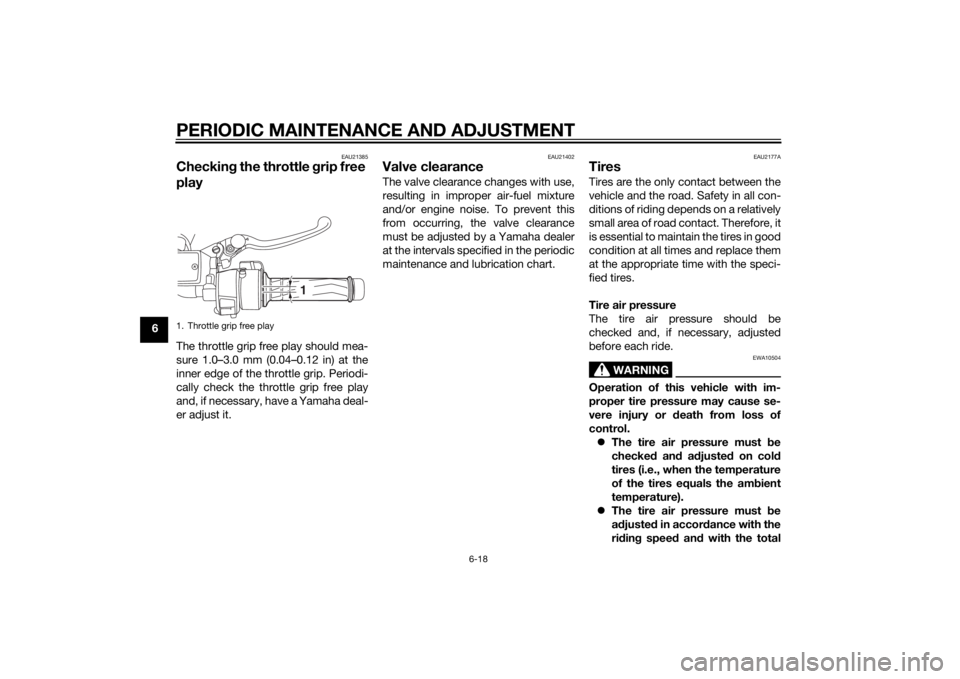
PERIODIC MAINTENANCE AND ADJUSTMENT
6-18
6
EAU21385
Checking the throttle grip free
playThe throttle grip free play should mea-
sure 1.0–3.0 mm (0.04–0.12 in) at the
inner edge of the throttle grip. Periodi-
cally check the throttle grip free play
and, if necessary, have a Yamaha deal-
er adjust it.
EAU21402
Valve clearanceThe valve clearance changes with use,
resulting in improper air-fuel mixture
and/or engine noise. To prevent this
from occurring, the valve clearance
must be adjusted by a Yamaha dealer
at the intervals specified in the periodic
maintenance and lubrication chart.
EAU2177A
TiresTires are the only contact between the
vehicle and the road. Safety in all con-
ditions of riding depends on a relatively
small area of road contact. Therefore, it
is essential to maintain the tires in good
condition at all times and replace them
at the appropriate time with the speci-
fied tires.
Tire air pressure
The tire air pressure should be
checked and, if necessary, adjusted
before each ride.
WARNING
EWA10504
Operation of this vehicle with im-
proper tire pressure may cause se-
vere injury or death from loss of
control.
The tire air pressure must be
checked and adjusted on cold
tires (i.e., when the temperature
of the tires equals the ambient
temperature).
The tire air pressure must be
adjusted in accordance with the
riding speed and with the total
1. Throttle grip free play
1
U1MDE1E0.book Page 18 Monday, July 28, 2014 10:48 AM
Page 91 of 124
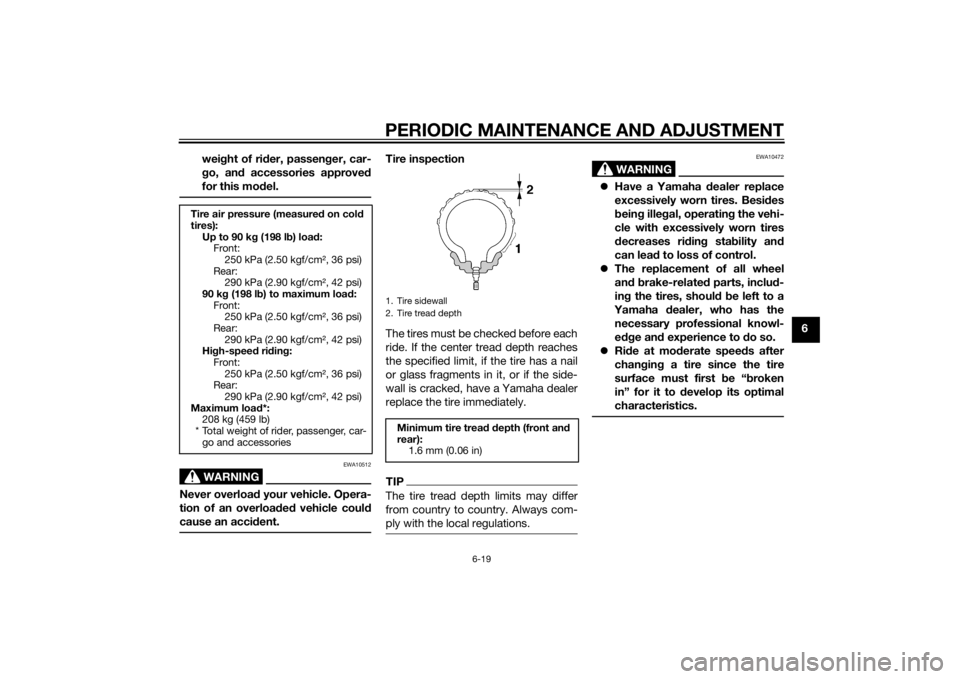
PERIODIC MAINTENANCE AND ADJUSTMENT
6-19
6 weight of rider, passenger, car-
go, and accessories approved
for this model.
WARNING
EWA10512
Never overload your vehicle. Opera-
tion of an overloaded vehicle could
cause an accident.
Tire inspection
The tires must be checked before each
ride. If the center tread depth reaches
the specified limit, if the tire has a nail
or glass fragments in it, or if the side-
wall is cracked, have a Yamaha dealer
replace the tire immediately.TIPThe tire tread depth limits may differ
from country to country. Always com-
ply with the local regulations.
WARNING
EWA10472
Have a Yamaha dealer replace
excessively worn tires. Besides
being illegal, operating the vehi-
cle with excessively worn tires
decreases riding stability and
can lead to loss of control.
The replacement of all wheel
and brake-related parts, includ-
ing the tires, should be left to a
Yamaha dealer, who has the
necessary professional knowl-
edge and experience to do so.
Ride at moderate speeds after
changing a tire since the tire
surface must first be “broken
in” for it to develop its optimal
characteristics.
Tire air pressure (measured on cold
tires):
Up to 90 kg (198 lb) load:
Front:
250 kPa (2.50 kgf/cm², 36 psi)
Rear:
290 kPa (2.90 kgf/cm², 42 psi)
90 kg (198 lb) to maximum load:
Front:
250 kPa (2.50 kgf/cm², 36 psi)
Rear:
290 kPa (2.90 kgf/cm², 42 psi)
High-speed riding:
Front:
250 kPa (2.50 kgf/cm², 36 psi)
Rear:
290 kPa (2.90 kgf/cm², 42 psi)
Maximum load*:
208 kg (459 lb)
* Total weight of rider, passenger, car-
go and accessories
1. Tire sidewall
2. Tire tread depth
Minimum tire tread depth (front and
rear):
1.6 mm (0.06 in)
U1MDE1E0.book Page 19 Monday, July 28, 2014 10:48 AM
Page 92 of 124
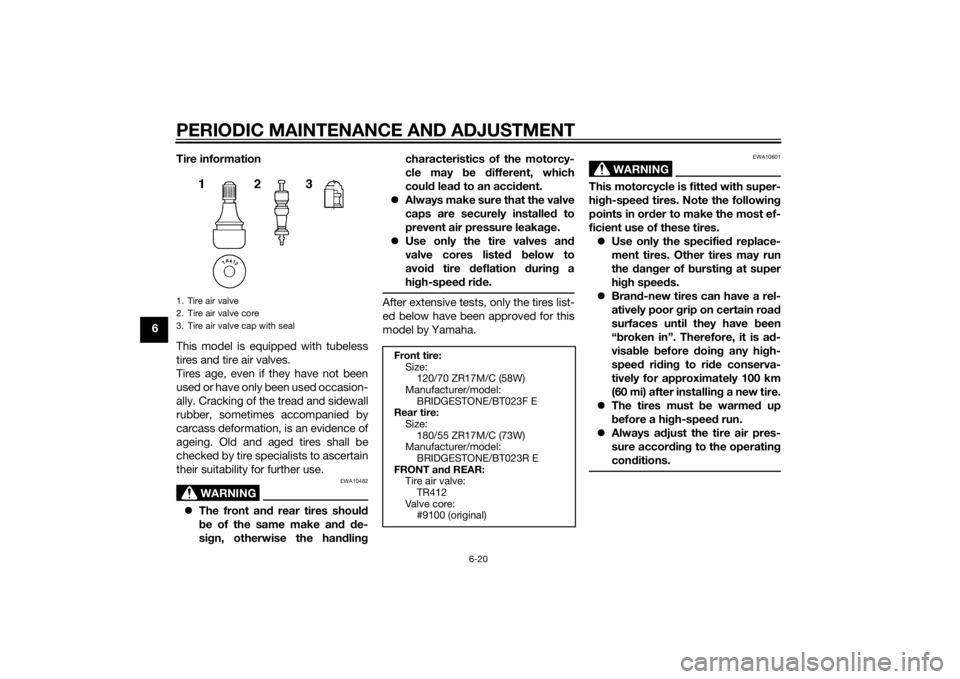
PERIODIC MAINTENANCE AND ADJUSTMENT
6-20
6Tire information
This model is equipped with tubeless
tires and tire air valves.
Tires age, even if they have not been
used or have only been used occasion-
ally. Cracking of the tread and sidewall
rubber, sometimes accompanied by
carcass deformation, is an evidence of
ageing. Old and aged tires shall be
checked by tire specialists to ascertain
their suitability for further use.
WARNING
EWA10482
The front and rear tires should
be of the same make and de-
sign, otherwise the handlingcharacteristics of the motorcy-
cle may be different, which
could lead to an accident.
Always make sure that the valve
caps are securely installed to
prevent air pressure leakage.
Use only the tire valves and
valve cores listed below to
avoid tire deflation during a
high-speed ride.
After extensive tests, only the tires list-
ed below have been approved for this
model by Yamaha.
WARNING
EWA10601
This motorcycle is fitted with super-
high-speed tires. Note the following
points in order to make the most ef-
ficient use of these tires.
Use only the specified replace-
ment tires. Other tires may run
the danger of bursting at super
high speeds.
Brand-new tires can have a rel-
atively poor grip on certain road
surfaces until they have been
“broken in”. Therefore, it is ad-
visable before doing any high-
speed riding to ride conserva-
tively for approximately 100 km
(60 mi) after installing a new tire.
The tires must be warmed up
before a high-speed run.
Always adjust the tire air pres-
sure according to the operating
conditions.
1. Tire air valve
2. Tire air valve core
3. Tire air valve cap with seal
Front tire:
Size:
120/70 ZR17M/C (58W)
Manufacturer/model:
BRIDGESTONE/BT023F E
Rear tire:
Size:
180/55 ZR17M/C (73W)
Manufacturer/model:
BRIDGESTONE/BT023R E
FRONT and REAR:
Tire air valve:
TR412
Valve core:
#9100 (original)
U1MDE1E0.book Page 20 Monday, July 28, 2014 10:48 AM
Page 93 of 124
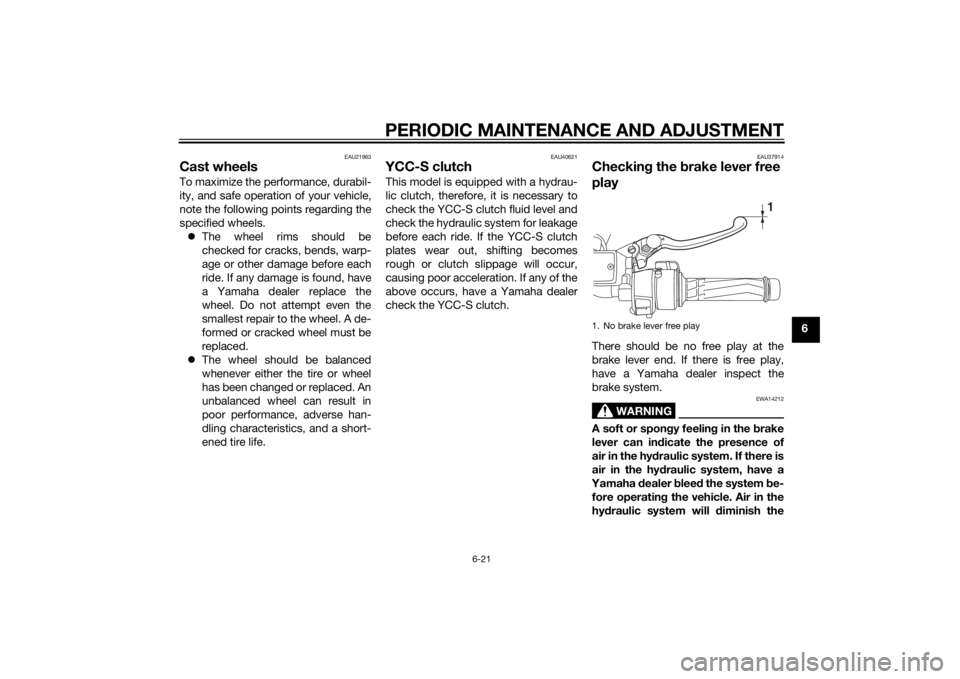
PERIODIC MAINTENANCE AND ADJUSTMENT
6-21
6
EAU21963
Cast wheelsTo maximize the performance, durabil-
ity, and safe operation of your vehicle,
note the following points regarding the
specified wheels.
The wheel rims should be
checked for cracks, bends, warp-
age or other damage before each
ride. If any damage is found, have
a Yamaha dealer replace the
wheel. Do not attempt even the
smallest repair to the wheel. A de-
formed or cracked wheel must be
replaced.
The wheel should be balanced
whenever either the tire or wheel
has been changed or replaced. An
unbalanced wheel can result in
poor performance, adverse han-
dling characteristics, and a short-
ened tire life.
EAU40621
YCC-S clutchThis model is equipped with a hydrau-
lic clutch, therefore, it is necessary to
check the YCC-S clutch fluid level and
check the hydraulic system for leakage
before each ride. If the YCC-S clutch
plates wear out, shifting becomes
rough or clutch slippage will occur,
causing poor acceleration. If any of the
above occurs, have a Yamaha dealer
check the YCC-S clutch.
EAU37914
Checking the brake lever free
playThere should be no free play at the
brake lever end. If there is free play,
have a Yamaha dealer inspect the
brake system.
WARNING
EWA14212
A soft or spongy feeling in the brake
lever can indicate the presence of
air in the hydraulic system. If there is
air in the hydraulic system, have a
Yamaha dealer bleed the system be-
fore operating the vehicle. Air in the
hydraulic system will diminish the1. No brake lever free play
1
U1MDE1E0.book Page 21 Monday, July 28, 2014 10:48 AM
Page 96 of 124
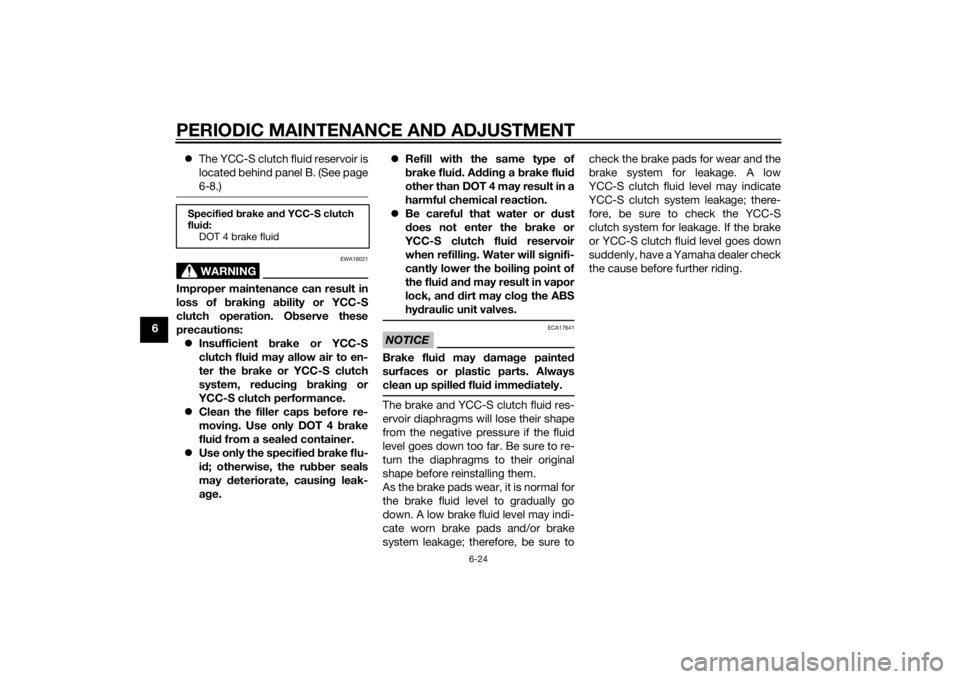
PERIODIC MAINTENANCE AND ADJUSTMENT
6-24
6The YCC-S clutch fluid reservoir is
located behind panel B. (See page
6-8.)
WARNING
EWA16021
Improper maintenance can result in
loss of braking ability or YCC-S
clutch operation. Observe these
precautions:
Insufficient brake or YCC-S
clutch fluid may allow air to en-
ter the brake or YCC-S clutch
system, reducing braking or
YCC-S clutch performance.
Clean the filler caps before re-
moving. Use only DOT 4 brake
fluid from a sealed container.
Use only the specified brake flu-
id; otherwise, the rubber seals
may deteriorate, causing leak-
age.Refill with the same type of
brake fluid. Adding a brake fluid
other than DOT 4 may result in a
harmful chemical reaction.
Be careful that water or dust
does not enter the brake or
YCC-S clutch fluid reservoir
when refilling. Water will signifi-
cantly lower the boiling point of
the fluid
and may result in vapor
lock, and dirt may clog the ABS
hydraulic unit valves.
NOTICE
ECA17641
Brake fluid may damage painted
surfaces or plastic parts. Always
clean up spilled fluid immediately.The brake and YCC-S clutch fluid res-
ervoir diaphragms will lose their shape
from the negative pressure if the fluid
level goes down too far. Be sure to re-
turn the diaphragms to their original
shape before reinstalling them.
As the brake pads wear, it is normal for
the brake fluid level to gradually go
down. A low brake fluid level may indi-
cate worn brake pads and/or brake
system leakage; therefore, be sure tocheck the brake pads for wear and the
brake system for leakage. A low
YCC-S clutch fluid level may indicate
YCC-S clutch system leakage; there-
fore, be sure to check the YCC-S
clutch system for leakage. If the brake
or YCC-S clutch fluid level goes down
suddenly, have a Yamaha dealer check
the cause before further riding.
Specified brake and YCC-S clutch
fluid:
DOT 4 brake fluid
U1MDE1E0.book Page 24 Monday, July 28, 2014 10:48 AM